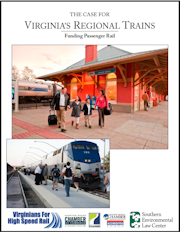 Inter-city passenger rail service is a wonderful thing… if it can pay its own way. The folks at the Department of Rail and Public Transportation managed to cut a really favorable deal with Amtrak, so the Virginia-backed regional service connecting Lynchburg and Richmond with Washington are both break-even propositions — virtually unheard of elsewhere in the country. Supposedly, the planned Norfolk-to-Washington passenger rail service will cover its costs as well. But new terms Amtrak is imposing on Virginia will likely be less advantageous. Over the next six years, the state will need $119 million to continue the operation of its six round-trip regional trains and to make passenger-rail infrastructure improvements in the current plans.
Inter-city passenger rail service is a wonderful thing… if it can pay its own way. The folks at the Department of Rail and Public Transportation managed to cut a really favorable deal with Amtrak, so the Virginia-backed regional service connecting Lynchburg and Richmond with Washington are both break-even propositions — virtually unheard of elsewhere in the country. Supposedly, the planned Norfolk-to-Washington passenger rail service will cover its costs as well. But new terms Amtrak is imposing on Virginia will likely be less advantageous. Over the next six years, the state will need $119 million to continue the operation of its six round-trip regional trains and to make passenger-rail infrastructure improvements in the current plans.
A new report, “The Case for Virginia’s Regional Trains,” advances an argument for making that investment. Amtrak ridership has surged 50% over the past five years, says the report. If there’s a likelihood that ridership will continue increasing at that rate, thus improving the economics of the service, then perhaps it’s an investment we should make.
But that’s a big if. More to the point: How many riders are using the trains? How many motorists are we taking off the roads? How much pollution are we preventing? What kind of Return on Investment are we getting for our public dollar? Can we improve the financial return by dropping under-performing rail connections? Finally, will Virginia be in a position six years from now to continue subsidizing passenger rail? The report doesn’t tell us. Perhaps that’s because no one in Virginia has been accustomed to document the ROI for any transportation project, including roads and highways. We need to start doing so.
— JAB


